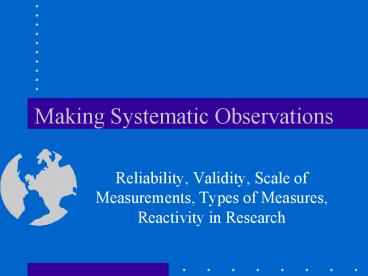Making Systematic Observations PowerPoint PPT Presentation
1 / 9
Title: Making Systematic Observations
1
Making Systematic Observations
- Reliability, Validity, Scale of Measurements,
Types of Measures, Reactivity in Research
2
Reliability
- Ability of a measure to produce similar results
on repeated occasions. - Physical Measures precision is important
- Population Estimates average values between
samples (with reasonable margin of errors) - Multiple Observers Interrater reliability
- Tests or Measures
- test-retest reliability parallel forms
reliability split-half reliability
3
Accuracy of a measure
- Accuracy Does the measure produce results that
agree with a known standard? - Can be compromised by lack of precision, but can
still be accurate if observations agree with the
standard on average - However precision is not necessarily accuracy
- Discrepancies between the standard value is
called a bias. - Ex False-Uniqueness Bias.
- The need for standardization for psychological
measurements.
4
Validity
- Does the measure/test measure what it is intended
to measure? - Face validity judging by its appearance.
- Ex Math questions on math tests.
- Content validity Do items (content) represent
the characteristic/behaviors that the measure was
designed to look for? - Ex An employment test that entails skills
necessary for the particular job. - Criterion-related validity Can the score of one
measure be used to infer the value on some other
measure? (two types concurrent validty
predictive validity)
5
Validity (cont).
- Construct Validity Do high scores or low scores
on a test indicate what they are supposed to as
predicted by the theory? - Ecological validity The extent to which results
can be applied to the natural setting. - Similar to external validity.
6
Four Scales of Measurements
- Scaling the data along four scales of
measurement, depending on needs of research
question. - Nominal Scales Ex Yes or No
- Ordinal Scales Ex Not much, Moderately, A lot
- Interval Scales Ex thermometer
- Ratio Scale Ex Absolute Zero (in Kelvin Scale)
- Need can vary by the amount information you want
and the need to preserve ecological validity.
7
Types of dependent measures
- Behavioral Measures Records actual behaviors of
participants - presence or absence of behavior
- Frequency of behavior
- latency and reaction time
- error behaviors (learning experiment)
- Physiological Measures Ex heart rate,
respiration rate, brain activity, eye movement,
etc. - Self-report Measures Used to assess behaviors
and attitudes, commonly using rating scales.
8
Reactivity in Research
- Design must consider how participants would react
to the experimental situation - Validity can be affected by Demand
Characteristics - defn Expected responses of the participant due
to cues provided by the researcher and the
context that may communicate the purpose of the
study) - Role attitude cues change in participants
attitude to conform with role as a research
participant (cooperative, apprehensive, negative
attitudes) - Experimenter bias expectancy effects
- Mitigating experimenter bias through single-blind
and double-blind studies
9
Detecting and Correcting Problems
- Pilot study
- Clarifying instructions
- Minimize range effects
- Determining reliability and validity
- Manipulation checks Did the participants
perceive the experiment in the manner in which it
was intended? - Validity of the independent variable
- Ask participants to report their perception of
the purpose of the study, of the experimenter,
and other factors that are important.

